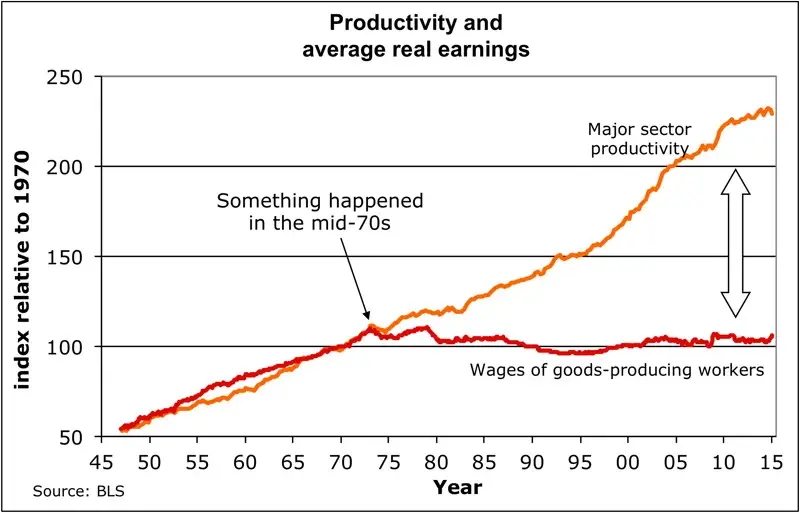
Saw a post about this at !history@hexbear.net and was a bit confused by exactly how badly the people there were going at each others throats in the comments. Nobody seemed able to agree on what precisely happened in 1971. Suggested explanations included:
- Neoliberalism being declared the state religion by Grand Moff Richard Nixon
- The gold standard being abolished
- The oil crisis
- The Republican and Democrat parties becoming increasingly divided
- Declining birthrates
- Institutional Racism
If any of you could give some explanations with, like, sources that aren’t just 10 pages of graphs with arrows pointing at 1971, that would be pretty great.
I know people always choose Hitler if they could go back in time and kill. Someone, but tbh I would choose Nixon, if I remember correctly, most of our problems we have in the US are directly related to him and his fucking over America for corporate greed.
American healthcare is what it is today because of Nixon and Kaiser Permanente.
I was born. I am so sorry y’all.
Why did you do this to us? Why‽
Boy if that isn’t my mother to a T.
I think they all played a role, but it was Nixon’s neoliberalism that prevented the trend from correcting.
I know I could probably just google it but for the sake of contributing to this discussion and my curiousity, what exactly is neoliberalism?
You’re better off googling it, they’ll do a better job explaining it than me.
It’s an economic ideology, and tldr the problematic positions are supporting laissez-faire capitalism, and privatization and commodification of everything.
The short answer is that corporate lobbying exploded starting in the early 70’s.
This is a deep and complex topic but the TL;DR is: money talks and this was the moment in US history where the people with the money were allowed direct access to the lawmaking process in congress. For the first time in history lobbyists were allowed to sit in congressional committee meetings and not just wait in the hallway outside. From that point on, corporate America has had more ‘representatives’ in congress than US citizens do.
And businesses only care about profits, and the single biggest expense most businesses have is labor. Decreased labor cost = more profits. So one of the first things that happened is wages stopped growing.
There is so much to talk about here including how and why it happened, who caused it (spoiler: Nixon is a recurring character), and what other impacts it had (too many to list).
This website does a great job of laying out the argument and providing citations: congressionalresearch.org. There are also some very helpful charts that really drive home the impact the increase in lobbying has had.
If you’re interested in this sort of thing I also recommend reading about The Powell Memorandum, 1971 which is basically the blueprint for modern capitalism and advocates specifically for increased corporate lobbying. Fun fact: It is also considered by some to be a forerunner to Project 2025.
There are a lot of other good points being brought up like decreased union membership but I would argue that increased lobbying is the root cause and all other explanations are symptoms.
There’s a fair amount of evidence linking wage stagnation over the last 50 years to erosion of collective bargaining and union membership. Unless there are very strong incentives companies are not going to pay employees more than they need to. Employees as a group have a lot of bargaining power, but as individuals, very little. Unless you happen to worn in a highly skilled, and high demand occupation, which are exactly the jobs that have seen wages remain comparatively high.
Thank you. I love when people cite sources
The gold standard was the only thing ensuring the dollar didn’t lose all its value. Poor people hold dollars while rich people knew about this. This is how we got here with that much inequality
The Gold standard couldn’t be sustained. Basically, the U.S. was no longer just exporting shittons of product and making a killing, it was now also importing a lot. The shift of that balance meant that keeping the ratio of 35 dollars per troy ounce of gold was nigh impossible.
Categorically false.
The problem with a gold standard is that your monetary supply can’t increase with your population, unless you can also increase your gold reserves at the same rate. If your monetary supply can’t keep pace with the population, then your money increases in value. That’s a bad thing; it makes it more expensive to buy anything, or to use any kind of credit.
A way to explain it is that if you have 100 people, and $1000, then you have an average of $10/person. But if your population increases to 110, and you still have the same amount of money, then you have an average of $9.09/person. But that $9.09 has the same purchasing power as $10 had previously. The result is that people hold on to money, since it’s going to be far more valuable in a few years than it is now. This is a form of deflation, and it’s a good way to crash an economy.
Going off the gold standard allows the federal reserve to more readily manipulate the monetary supply–they don’t have to hold reserves of gold or silver–to keep an economy growing along with a population.
Deflation is only bad for the rich. You are spitting bad justifications for the end of the gold standard. There is only one reason it was ended : the USA defaulted as their gold reserve was empty after all major actors like France demanded their gold back
Really? You think that deflation is good for workers? Deflation means that they get laid off, because why the fuck would I, were I an employer, continue to employ someone when their effective wage rises ever year, if I can get someone for half the real wages? Deflation means that no one is going to get a mortgage, because you’re going to be underwater on that loan before the ink is dry; that also means that you won’t be able to sell a house if you need to. With deflation, everyone puts of discretionary purchases, because the increasing value of money means that those purchases will be cheaper at a later date. With everyone stopping discretionary spending, you see a very rapid halt to the economy.
We have a winner!
That’s what brainless ancaps think.
No literally.
For anyone who hasn’t seen it: wtfhappenedin1971.com
To be clear, that one is not as insightful as one may initially think. See https://singlelunch.com/2023/09/13/the-bad-economics-of-wtfhappenedin1971/
I think your source is the best answer I’m going to get
Anyone knows where to find data for European countries or the EU?
It’s been a ling time that we should be able to work less and have more freedom IMO but I’d love having it backed up by raw numbers like this.
https://www.socialeurope.eu/wage-productivity-gap-four-tales-from-the-eurozone has some graphs, although I don’t see data sources
1970 was the last time the government collected more than 3% of GDP in taxes. After that point, there was less and less of a need to avoid taxation.
We need a new tax bracket for the ultra wealthy. The top current bracket is 37% above ~$300,000. For most of the 20th century, the top tier tax bracket was 91%. We need a 91% tax bracket on income beyond $600,000. We need some sharp incentive for the wealthiest among us to avoid.
You’re thinking like one of the poors. Us ultra wealthy don’t get paid in dollars. We get paid in shares. And we don’t sell the shares, we take out long term low interest bank loans with the shares as collateral any time we absolutely need to use cash.
https://finance.yahoo.com/news/invest-borrow-against-die-scott-114400643.html
First off, your link is about 80% tracking information. You can remove the “?” and everything that follows it.
You are correct. The value of those shares should be considered income and taxed at the time of transfer. If they were, the 91% top-tier tax bracket would catch most of their excess income. Since that isn’t happening, we need additional measures.
Capital gains tax should be higher than income tax. It is patently absurd that sitting around waiting for your money to make more money is taxed less than busting your ass for 40+ hours a week. With capital gains taxed higher than income, businesses will want to pay a larger percentage of their workers with shares rather than simple income.
More importantly, we need a specific type of wealth tax. We don’t need to tax all wealth: We need to tax financial assets. Registered securities. The vehicles that the ultra wealthy use to exponentially transfer wealth out of the economy.
We should tax registered securities at 1-3% per year. Natural persons holding less than $10 million in securities are exempt. That keeps 99% of taxpayers from owing this tax.
The securities tax should be paid in shares of the security, transferred directly to the IRS. By paying directly in shares, they don’t have to find a buyer; the don’t have to liquidate them, so they won’t be dragging down prices for everyone else. The IRS will sell off these shares over time, such that IRS liquidation sales never comprise more than 1% of total traded volume.
Securities are shares of the “means of production”. A securities tax will drive ownership of those shares toward the working class.
My accounting team told me they would open more Panamanian shell companies for me, and the shares would get distributed across them. I’d retain full ownership, of course.
-
If they are holding shares that can be traded in US markets, the SEC knows about those shares, and ultimately controls those shares. They don’t need your Panamanian shell company to release them. You’ll wake up one morning to find that a portion of the shares formerly in your shell company’s portfolio are now in the IRS’s portfolio. The SEC just ctrl-x’d them from your portfolio, and ctrl-v’d them to the IRS.
-
Your Panamanian shell company is not a “natural person”. Only “natural persons” are eligible for the $10 million dollar exemption. Your shell company pays the tax on its entire portfolio, not just the excess above $10 million.
So you want to tax all companies a percent of their stock ownership every year? Good luck with that.
You’re falling intro a trollhill. The point is the ultra-wealthy pay very smart people to work out loopholes. If some internet retard can run around your ideas and keep you busy, a team of full time financial experts will have a field day. This is not an easy problem to solve. Pretending like it is leads to support for crappy subpar legislation that doesn’t work.
Not at all.
Companies shouldn’t be owning stock.
Companies issue their own stock. They don’t own it. The shareholders who buy it or otherwise acquire it are the owners. And if those owners have more than $10 million worth of it, they can afford to pay 1% of everything they own beyond that first $10 million.
I won’t prohibit companies from owning other publicly traded companies, but they don’t get special status when they do. That status is reserved for natural persons, and only $10 million of the the stock owned by such a person is exempt from taxation.
The point is the ultra-wealthy pay very smart people to work out loopholes.
Correct. The securities tax I’m talking about is not the actual solution. The loopholes they use to avoid that securities tax is the solution. The actual solution is for them to actually spend their wealth and enjoy their lives, rather than treating the economy like some idle clicker.
-
We need a 91% tax bracket on income beyond $600,000. We need some sharp incentive for the wealthiest among us to avoid.
This is a fantastic idea, and it wouldn’t actually require eating any of them, necessarily.
Ultra wealthy got so rich you won’t undo inequality with just income tax. There needs to be a cap on existing wealth and if they opposed income tax, they won’t part with it willingly.
No sources from me, only uneducated guesswork.
Two events of 1971 stand out to me, as I knew of them beforehand:
- My brother was born. Not relevant to the question at hand (I hope), I just wanted to mention it.
- The oil crisis.
The latter strikes me as probably a big factor. The world was basically using oil for everything (Even more so than now), and an oil shortage (or fear thereof) is likely to send a drastic shock to the system. Manufacturing, logistics, energy, EVERYTHING becomes more expensive, resulting in having to do more with less.
Shortly after the (percieved) shortage, there was an oil glut and overcorrection. I’m not clever enough to say what effect this would have in exact terms, but I highly doubt that an already turbulent world economy did well because of it.
So what your saying is your brother single-handedly altered the trajectory of the US economy
I always knew their brother had something to do with this ever since 2 minutes ago.
That’s what I’m taking from this, as well.
Oil rebounded, but Reagan/Thatcher era neoliberal policy remains. I’m not saying the oil crisis wasn’t a factor, but I think this lasting wage stagnation has more to do with explicit policy that promoted oligopolies than it does to do with the supply of energy resources.
The first oil crisis was in 1973, which is roughly what the graph suggests.
In 1971 the oil-fuelled postwar party was still in full swing.
confused by exactly how badly the people there were going at each others throats in the comments
I’m reading that thread and I don’t see anyone being aggressive.
someone there also mentioned Nixonland which actually is a good book to understand the circumstances of era
I don’t think that anything significant happened in that particular year to produce an long-term difference, but computers were becoming a lot more common around that time.
As countries develop economically, they start out with a large primary sector, sometimes called the “agricultural sector”. That deals with agriculture, mining, fishing. Extracting raw resources from the land.
As they develop, the size of the primary sector declines relative to the secondary sector, sometimes called the “manufacturing sector”. It takes in raw resources, and converts them into processed goods.
As they develop still further, the size of the secondary sector declines relative to the tertiary sector, sometimes called the “service sector”… These are services – people do work that doesn’t involve processing resources.
https://en.wikipedia.org/wiki/Three-sector_model
According to the three-sector model, the main focus of an economy’s activity shifts from the primary through the secondary and finally to the tertiary sector. Countries with a low per capita income are in an early state of development; the main part of their national income is achieved through production in the primary sector. Countries in a more advanced state of development, with a medium national income, generate their income mostly in the secondary sector. In highly developed countries with a high income, the tertiary sector dominates the total output of the economy.
The US underwent a good bit of that secondary-tertiary transition in vaguely the timeline that you’re looking at.
The way a market allocates labor in the economy is via wages. If there is a lot of demand for labor for a given job relative to supply, wages for that job rise. This causes more workers to shift into that job. If there is little demand for labor for a given job relative to supply, wages fall. This causes workers to shift out of that job.
The US used to do a lot of low-skill assembly-line production, a lot like China does today. It used workers who were coming off farms – just like China has. Forged a lot of the practices involved, in fact:
https://en.wikipedia.org/wiki/American_system_of_manufacturing
The American system of manufacturing was a set of manufacturing methods that evolved in the 19th century.[1] The two notable features were the extensive use of interchangeable parts and mechanization for production, which resulted in more efficient use of labor compared to hand methods. The system was also known as armory practice because it was first fully developed in armories, namely, the United States Armories at Springfield in Massachusetts and Harpers Ferry in Virginia (later West Virginia),[2] inside contractors to supply the United States Armed Forces, and various private armories. The name “American system” came not from any aspect of the system that is unique to the American national character, but simply from the fact that for a time in the 19th century it was strongly associated with the American companies who first successfully implemented it, and how their methods contrasted (at that time) with those of British and continental European companies. In the 1850s, the “American system” was contrasted to the British factory system which had evolved over the previous century. Within a few decades, manufacturing technology had evolved further, and the ideas behind the “American” system were in use worldwide. Therefore, in manufacturing today, which is global in the scope of its methods, there is no longer any such distinction.
The American system involved semi-skilled labor using machine tools and jigs to make standardized, identical, interchangeable parts, manufactured to a tolerance, which could be assembled with a minimum of time and skill, requiring little to no fitting.
Since the parts are interchangeable, it was also possible to separate manufacture from assembly and repair—an example of the division of labor. This meant that all three functions could be carried out by semi-skilled labor: manufacture in smaller factories up the supply chain, assembly on an assembly line in a main factory, and repair in small specialized shops or in the field. The result is that more things could be made, more cheaply, and with higher quality, and those things also could be distributed further, and lasted longer, because repairs were also easier and cheaper. In the case of each function, the system of interchangeable parts typically involved substituting specialized machinery to replace hand tools.
So when that transition happens, what you’re gonna see is manufacturing industry going into relative decline. That’s gonna mean reduced relative demand for labor, and it’ll put downwards pressure on wages.
The US still manufactures a fair bit of stuff in dollar value – more than in the past in dollar terms, though the manufacturing sector is smaller as a relative percentage of the economy. However, the manufacturing processes it uses today tend to rely a lot on computerized automation, so that you don’t require a lot of low-skill labor on an assembly line, which employ comparatively-few people to manufacture a lot of stuff – they have high productivity, produce a lot in dollar terms per person employed.
inflation basically
From ChatGPT:
Ending the Bretton Woods system in 1971 had a cascading effect on corporate profits and income distribution. Wealth shifting toward shareholders and executives rather than workers:
1. Deregulation of Money and Credit
Once the dollar was no longer tied to gold, the U.S. government and Federal Reserve had more flexibility in managing the money supply. This led to:
• Higher inflation, which eroded workers’ real wages.
• Easier access to credit, fueling corporate financialization (more focus on stock buybacks, mergers, and financial engineering instead of wage growth).
2. Rise of Shareholder Capitalism
With the shift away from the gold standard, corporate governance changed. Instead of focusing on long-term growth and worker stability, companies prioritized maximizing shareholder value, which became a dominant ideology by the 1980s (reinforced by Milton Friedman’s theories).
• Stock Buybacks & Dividends – Companies increasingly used profits to buy back shares, boosting stock prices and benefiting executives/shareholders.
• Executive Compensation in Stocks – CEO pay shifted from salaries to stock options, aligning their interests with shareholders rather than employees.
3. Decline in Labor’s Bargaining Power
As globalization and automation accelerated, companies could move production abroad, weakening the leverage of American workers. Meanwhile:
• Unions declined, further reducing workers’ ability to demand wage increases.
• Deregulation in industries like finance, airlines, and trucking shifted power away from labor and toward corporate management.
4. Explosion of Financialization
The detachment from gold allowed an unrestricted credit boom, fueling speculative bubbles and making the financial sector more dominant. Instead of reinvesting profits into worker wages or capital expansion, firms:
• Focused on financial activities (derivatives, leveraged buyouts, etc.), which benefited investors rather than workers.
• Moved toward short-term profits, cutting costs via outsourcing and automation.
End Result
With productivity still rising but wages stagnating, the gains went disproportionately to executives and shareholders. This is why, after 1971, you see charts showing a widening gap between worker pay and corporate profits.
I hate these LLMs but must admit that’s a damn fine synopsis
Probably the best thing I’ve seen out of GPT so far.











